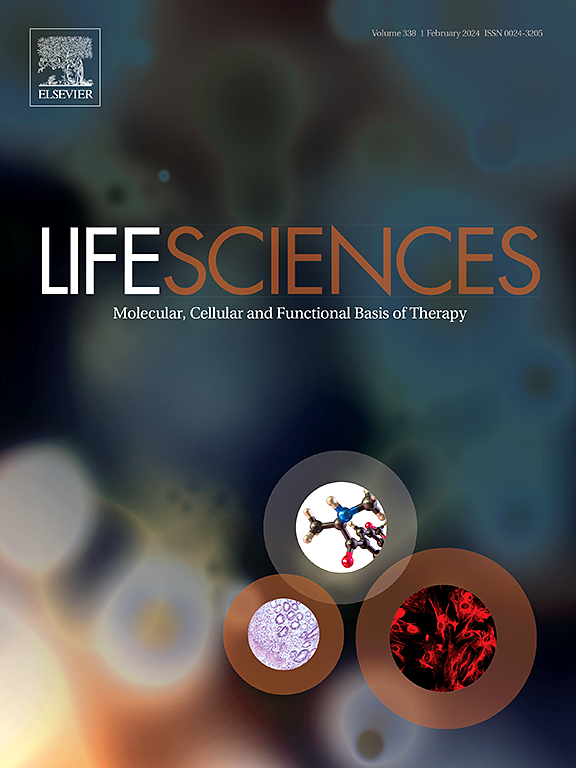电针结合 NSCs-Exo 可改变卵巢大鼠海马神经元在慢性不可预测轻度应激范式中的反应。
IF 5.2
2区 医学
Q1 MEDICINE, RESEARCH & EXPERIMENTAL
引用次数: 0
摘要
电针(EA)是一种中医疗法,它将针灸与模仿人体生物电的微电流相结合,以预防和治疗疾病。以往的研究表明,针灸对慢性不可预测轻度应激(CUMS)诱导的卵巢切除(OVX)大鼠有类似抗抑郁的作用。神经干细胞衍生的外泌体(NSCs-Exo)具有异质性和靶向性,能有效促进神经再生和修复神经元损伤,同时可能传递EA的效应。然而,其确切机制仍不清楚。本研究采用 CUMS + OVX 两步法建立了围绝经期抑郁障碍(PDD)大鼠模型。EA联合NSCs-Exo(EA-Exo)治疗可显著改善PDD大鼠的抑郁样行为,表现为蔗糖偏好试验(SPT)中蔗糖摄入量增加、强迫游泳试验(FST)中不动性降低以及视野外试验(OFT)中活动延长。EA-Exo治疗可通过提高血清中5-羟色胺(5-HT)的水平和减少FST中的不动性来改善抑郁样行为。它还通过提高血清中5-羟色胺(5-HT)、多巴胺(DA)、ATP、超氧化物歧化酶(SOD)和白细胞介素-10(IL-10)的水平,同时降低环磷酸腺苷(cAMP)、白细胞介素-6(IL-6)、活性氧(ROS)和丙二醛(MDA)的水平,缓解了OVX-CUMS诱发的能量代谢紊乱、炎症和氧化应激反应。此外,EA-Exo 治疗还能逆转海马突触和线粒体的结构和功能损伤。海马突触可塑性蛋白 PSD95、SYN 和 GAP43 的减少,以及能量代谢通路蛋白 AMPK、NRF1、PGC1α 和 TFAM 表达的减少都证明了这一点。这些研究结果表明,EA-Exo可通过调节突触可塑性和激活AMPK/NRF1/PGC1α/TFAM信号通路来改善OVX-CUMS大鼠的抑郁行为。本文章由计算机程序翻译,如有差异,请以英文原文为准。
Electroacupuncture combined with NSCs-Exo alters the response of hippocampal neurons in a chronic unpredictable mild stress paradigm in ovx rats
Electroacupuncture (EA) is a form of Traditional Chinese Medicine (TCM) that combines acupuncture with microcurrents mimicking the body's bioelectricity to prevent and treat diseases. Previous studies have demonstrated its antidepressant-like effects in chronic unpredictable mild stress (CUMS)-induced ovariectomy (OVX) rats. Neural stem cell-derived exosomes (NSCs-Exo) are heterogeneous and targeted, effectively promoting nerve regeneration and repairing neuronal damage, while potentially conveying the effects of EA. However, the precise mechanism remains unclear. In this study, perimenopausal depressive disorder (PDD) rat model were established using a two-step protocol CUMS + OVX. Treatment with EA combined with NSCs-Exo (EA-Exo) significantly improved depression-like behaviors in PDD rats, as indicated by increased sucrose intake in the Sucrose Preference Test (SPT), reduced immobility in the Forced Swimming Test (FST), and prolonged activity in the Out-of-Field Test (OFT). EA-Exo treatment improved depression-like behaviors by increasing serum levels of 5-hydroxytryptamine (5-HT) and decreasing immobility in the FST. It also alleviated OVX-CUMS-induced disturbances in energy metabolism, inflammation, and oxidative stress responses by enhancing serum levels of 5-HT, dopamine (DA), ATP, superoxide dismutase (SOD), and interleukin-10 (IL-10), while reducing cyclic AMP (cAMP), interleukin-6 (IL-6), reactive oxygen species (ROS), and malondialdehyde (MDA). Furthermore, EA-Exo treatment reversed structural and functional impairments in hippocampal synapses and mitochondria. This was evidenced by reductions in hippocampal synaptic plasticity proteins PSD95, SYN, and GAP43, as well as decreased expression of energy metabolism pathway proteins AMPK, NRF1, PGC1α, and TFAM. These findings suggest that EA-Exo ameliorates depressive behavior in OVX-CUMS rats by modulating synaptic plasticity and activating the AMPK/NRF1/PGC1α/TFAM signaling pathway.
求助全文
通过发布文献求助,成功后即可免费获取论文全文。
去求助
来源期刊

Life sciences
医学-药学
CiteScore
12.20
自引率
1.60%
发文量
841
审稿时长
6 months
期刊介绍:
Life Sciences is an international journal publishing articles that emphasize the molecular, cellular, and functional basis of therapy. The journal emphasizes the understanding of mechanism that is relevant to all aspects of human disease and translation to patients. All articles are rigorously reviewed.
The Journal favors publication of full-length papers where modern scientific technologies are used to explain molecular, cellular and physiological mechanisms. Articles that merely report observations are rarely accepted. Recommendations from the Declaration of Helsinki or NIH guidelines for care and use of laboratory animals must be adhered to. Articles should be written at a level accessible to readers who are non-specialists in the topic of the article themselves, but who are interested in the research. The Journal welcomes reviews on topics of wide interest to investigators in the life sciences. We particularly encourage submission of brief, focused reviews containing high-quality artwork and require the use of mechanistic summary diagrams.
 求助内容:
求助内容: 应助结果提醒方式:
应助结果提醒方式:


